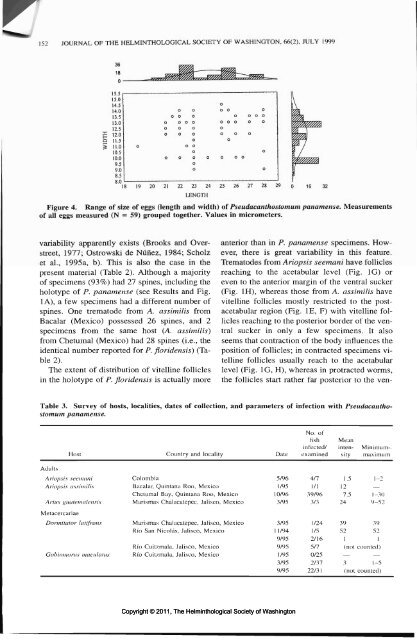The Helminthological Society of Washington - Peru State College
The Helminthological Society of Washington - Peru State College
The Helminthological Society of Washington - Peru State College
Create successful ePaper yourself
Turn your PDF publications into a flip-book with our unique Google optimized e-Paper software.
152 JOURNAL OF THE HELMINTHOLOGICAL SOCIETY OF WASHINGTON, 66(2), JULY 1999<br />
15.5<br />
15.0<br />
14.5<br />
14.0<br />
13.5<br />
13.0<br />
12.5<br />
JE 12.0<br />
Q 11.5<br />
% 11.0<br />
10.5<br />
10.0<br />
9.5<br />
9.0<br />
8.5<br />
« n<br />
O 0<br />
o o o<br />
0 000<br />
o o o<br />
o o o<br />
o<br />
0 O O<br />
o<br />
o o o<br />
o<br />
o<br />
o<br />
o o<br />
o<br />
o o o o<br />
o o o o o<br />
o<br />
o o o<br />
o<br />
O O O 0<br />
18 19 20 21 22 24 25 26 27 28<br />
LENGTH<br />
Figure 4. Range <strong>of</strong> size <strong>of</strong> eggs (length and width) <strong>of</strong> Pseudacanthostomum panamense. Measurements<br />
<strong>of</strong> all eggs measured (N = 59) grouped together. Values in micrometers.<br />
o<br />
o<br />
variability apparently exists (Brooks and Overstreet,<br />
1977; Ostrowski de Nunez, 1984; Scholz<br />
et al., 1995a, b). This is also the case in the<br />
present material (Table 2). Although a majority<br />
<strong>of</strong> specimens (93%) had 27 spines, including the<br />
holotype <strong>of</strong> P. panamense (see Results and Fig.<br />
1A), a few specimens had a different number <strong>of</strong><br />
spines. One trematode from A. assimilis from<br />
Bacalar (Mexico) possessed 26 spines, and 2<br />
specimens from the same host (A. assimilis)<br />
from Chetumal (Mexico) had 28 spines (i.e., the<br />
identical number reported for P. floridensis) (Table<br />
2).<br />
<strong>The</strong> extent <strong>of</strong> distribution <strong>of</strong> vitelline follicles<br />
in the holotype <strong>of</strong> P. floridensis is actually more<br />
anterior than in P. panamense specimens. However,<br />
there is great variability in this feature.<br />
Trematodes from Ariopsis seemani have follicles<br />
reaching to the acetabular level (Fig. 1G) or<br />
even to the anterior margin <strong>of</strong> the ventral sucker<br />
(Fig. 1H), whereas those from A. assimilis have<br />
vitelline follicles mostly restricted to the postacetabular<br />
region (Fig. IE, F) with vitelline follicles<br />
reaching to the posterior border <strong>of</strong> the ventral<br />
sucker in only a few specimens. It also<br />
seems that contraction <strong>of</strong> the body influences the<br />
position <strong>of</strong> follicles; in contracted specimens vitelline<br />
follicles usually reach to the acetabular<br />
level (Fig. 1G, H), whereas in protracted worms,<br />
the follicles start rather far posterior to the ven-<br />
Table 3. Survey <strong>of</strong> hosts, localities, dates <strong>of</strong> collection, and parameters <strong>of</strong> infection with Pseudacanthostomum<br />
panamense.<br />
Host<br />
Country and locality<br />
No. <strong>of</strong><br />
fish Mean<br />
infected/ inten- Minimum-<br />
Date examined sity maximum<br />
Adults<br />
A riopsis see man i<br />
A riopsis assim His<br />
A rius guatemalensis<br />
Metacercariae<br />
Dormitator latifronx<br />
Gobiomorus maculatus<br />
Colombia<br />
Bacalar, Quintana Roo, Mexico<br />
Chetumal Bay, Quintana Roo, Mexico<br />
Marismas Chalacatepec, Jalisco, Mexico<br />
Marismas Chalacatepec, Jalisco, Mexico<br />
Rio San Nicolas, Jalisco, Mexico<br />
Rio Cuitzmala, Jalisco, Mexico<br />
Rio Cuitzmala, Jalisco, Mexico<br />
5/96<br />
1/95<br />
10/96<br />
3/95<br />
3/95<br />
11/94<br />
9/95<br />
9/95<br />
1/95<br />
3/95<br />
9/95<br />
4/7<br />
1/1<br />
39/96<br />
3/3<br />
1/24<br />
1/5<br />
2/16<br />
5/7<br />
0/25<br />
2/37<br />
22/31<br />
1.5 1-2<br />
12<br />
7.5 1-30<br />
24 9-52<br />
39 39<br />
52 52<br />
1 1<br />
(not counted)<br />
— —<br />
3 1-5<br />
(not counted)<br />
Copyright © 2011, <strong>The</strong> <strong>Helminthological</strong> <strong>Society</strong> <strong>of</strong> <strong>Washington</strong>
















